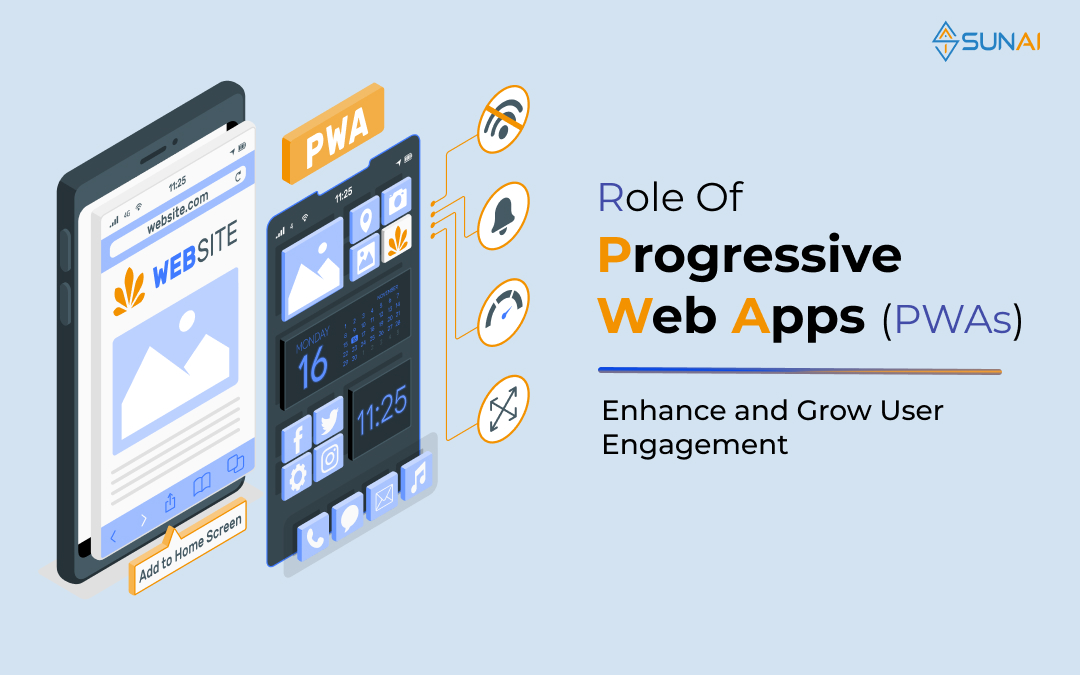In the ever-evolving digital landscape, user engagement stands as the cornerstone of successful web development. As technology advances, user expectations soar, demanding innovative strategies for engagement. This introduction sets the stage for a profound exploration of Progressive Web Apps and their pivotal role in transforming user engagement strategies across the web.
Embracing the Future of User Engagement
Imagine a time when browsing the web meant waiting for sluggish pages to load, dealing with clunky interfaces, and facing the frustration of limited functionality when offline. Traditional web development, although revolutionary in its own right, struggled to keep pace with the burgeoning demands of users. Websites often fall short of delivering immersive experiences, leaving users disenchanted and disengaged.
Enter Progressive Web Apps (PWAs) – a game-changer. Progressive Web Apps break free from these constraints, offering lightning-fast speeds, seamless transitions, and app-like experiences on the web. This shift from sluggish web experiences to immersive, responsive journeys highlights how PWAs revolutionized user engagement, bridging the gap between web accessibility and native app functionalities.
The Power of Progressive Web Apps: A Game Changer in Web Development
Progressive Web Apps have emerged as a transformative force in web development, offering a hybrid solution that combines the best features of websites and native apps. They provide seamless experiences across various devices, irrespective of network conditions. Dive deep into the specifics of PWAs, showcasing examples like Trivago, or Alibaba, and their exceptional user experiences. Highlight their ability to load instantly, even on low-speed connections, fostering increased user interaction and retention.
Let’s embark on a journey exploring 10 remarkable Progressive Web Apps that have reshaped the landscape of user engagement, setting new benchmarks for web development innovation. These Progressive Web Apps span different industries and demonstrate the unparalleled potential of this revolutionary technology.

Twitter Lite:
Breaking barriers with its fast-loading interface and offline capabilities, Twitter Lite offers a streamlined experience for users, especially in regions with limited connectivity. The PWA’s lightweight design ensures swift interactions without compromising on essential functionalities.

Flipkart:
Revolutionizing e-commerce, Flipkart’s PWA combines the convenience of a native app with the accessibility of the web. Its engaging interface, quick navigation, and push notifications keep users immersed in a seamless shopping experience.

Starbucks:
Brewed to perfection, the Starbucks PWA delights users with its intuitive design and personalized experiences. Ordering ahead, exploring the menu, and earning rewards seamlessly integrate into the user journey, fostering engagement and loyalty.

Trivago:
Transforming the travel industry, Trivago’s PWA offers a user-friendly platform for comparing hotel prices and making bookings. Its responsive design and offline functionalities ensure a smooth experience, empowering users to plan their travels effortlessly.

Forbes:
Forbes’ PWA brings news and insights to users with remarkable speed and accessibility. With quick article loading and a user-centric interface, it redefines content consumption, keeping readers engaged across various devices.

Lancôme:
A beauty in design and functionality, Lancôme’s PWA offers an immersive experience for cosmetics enthusiasts. From personalized recommendations to interactive product exploration, it elevates user engagement in the beauty industry.

The Washington Post:
Delivering news in a dynamic and accessible manner, The Washington Post’s PWA reimagines journalism. Its offline reading capabilities and interactive elements create a captivating user experience in the world of news consumption.

Alibaba:
Empowering e-commerce on a global scale, Alibaba’s PWA facilitates seamless transactions and immersive browsing experiences. Its user-friendly interface and offline functionalities cater to diverse consumer needs.

MakeMyTrip:
Redefining travel planning, MakeMyTrip’s PWA offers users a comprehensive platform for booking flights, hotels, and activities. Its intuitive design and personalized recommendations enhance the user journey, ensuring continued engagement.

Ola:
Transforming the way people commute, Ola’s PWA ensures hassle-free ride booking and tracking. Its lightweight design and real-time updates provide users with a smooth and engaging travel experience.
Explore Our Web Application Development Service.
Creating Engaging User Experiences: How Progressive Web Apps Stand Out
The unique features of Progressive Web Apps set them apart in terms of user engagement. To truly grasp the transformative impact of Progressive Web Apps (PWAs) on user engagement and customer satisfaction, let’s draw wisdom from the voices that echo within the realms of user experience and business innovation.
“Design isn’t just what it looks like and feels like — design is how it works.”
Steve Jobs, Co-founder of Apple
Steve Jobs emphasized that design transcends aesthetics; He says, that UX design is more than just aesthetics; it’s about the seamless operation of a product or interface, aligning it with user needs and behaviors. It goes beyond visual appeal, focusing on intuitive navigation, smooth interactions, and overall usability. The goal is to create experiences that not only appear pleasing but also feel instinctive, building a bond between the user and the product. Emphasizing functionality and ease of use elevates design’s significance, enhancing user satisfaction, and nurturing lasting engagement throughout their journey.
“A user interface is like a joke. If you have to explain it, it’s not that good.”
Martin LeBlanc, CEO and founder of IconFinder
Martin LeBlanc’s analogy underscores the essence of intuitive user interface (UI) design. A well-crafted UI should be self-explanatory, requiring minimal guidance or explanation. Just as a good joke doesn’t need elaboration to be understood, a great UI anticipates user needs, offering an instinctive and clear pathway for interaction. It ensures users effortlessly navigate without confusion or the need for additional instructions, fostering a seamless and delightful user experience.
“Your old site is the best prototype of your new site.”
Hoa Loranger, Vice President at Nielsen Norman Group
Hoa Loranger’s insight underscores the importance of learning from existing designs. The current website serves as a valuable prototype for the new one, offering insights into user behaviors, pain points, and successful features. It serves as a blueprint, highlighting what works well and what needs improvement. By analyzing user interactions and feedback from the old site, designers can refine the new site’s UX, integrating successful elements while addressing previous shortcomings to create an enhanced and more user-centric experience.
“Design is the silent ambassador of your brand.”
Paul Rand, Art Director and Graphic Designer who designed the IBM logo
Paul Rand’s quote emphasizes that design communicates the essence of a brand without words. In the realm of UX, every interaction, visual element, and functionality within a product or interface speaks volumes about the brand’s identity and values. A well-crafted UX serves as an ambassador, shaping perceptions and emotions associated with the brand. It reflects the brand’s commitment to user satisfaction, leaving a lasting impression that resonates with users long after their interaction, ultimately defining the brand’s reputation and relationship with its audience.
These endorsements from industry leaders and experts underscore the significant impact of PWAs in reshaping user engagement and satisfaction. Their insights reinforce the notion that Progressive Web Apps aren’t just a technological advancement but a catalyst for redefining how businesses connect with their audiences, forging stronger bonds, and delivering unparalleled user experiences.
Key Features of Progressive Web Apps That Ignite User Engagement
The technical aspects are fundamental to understanding how Progressive Web Apps enhance engagement.
- Did You Know? PWAs Can Boost Conversions by up to 300%: Studies reveal that implementing a PWA strategy can result in a significant surge in conversion rates. Businesses leveraging PWAs witness a substantial increase in conversions, sometimes exceeding 300%, attributed to enhanced user experiences and streamlined functionalities.
- Did You Know? PWAs Can Reduce Bounce Rates by 50%: Traditional websites often grapple with high bounce rates, leading users to navigate away swiftly. However, Progressive Web Apps, with their lightning-fast loading times and engaging interfaces, have demonstrated a remarkable ability to cut bounce rates in half, retaining users and fostering longer sessions.
- Did You Know? PWAs Can Decrease Page Load Times by 90%: One of the standout features of Progressive Web Apps is their ability to load almost instantly, irrespective of network conditions. They significantly reduce page load times, providing users with a swift and seamless browsing experience, thereby enhancing engagement and satisfaction.
- Did You Know? PWAs Can Function with 80% Less Data Consumption: For users in regions with limited data access, PWAs offer a boon. Their efficient use of data allows them to operate with considerably less data consumption compared to traditional apps or websites, ensuring accessibility even in low-bandwidth environments.
- Did You Know? PWAs Can Improve User Re-engagement by 50%: With the capacity to send push notifications and offer offline functionalities, PWAs excel in re-engaging users. They boast a remarkable 50% improvement in user re-engagement rates, ensuring continued interaction and fostering brand loyalty.
The Road to Success: Implementing Progressive Web Apps in Your Web Development Strategy
Practical guidance is pivotal for businesses and developers planning to adopt Progressive Web Apps.
Your PWA Implementation Journey: A Visual Roadmap
Imagine having a visual compass to navigate the intricate landscape of adopting Progressive Web Apps (PWAs). Our step-by-step guide in the form of an interactive infographic or flowchart simplifies the implementation process, transforming complexity into clarity for readers venturing into the realm of PWAs.
- Step 1: Understanding Your Goals: The journey commences by defining your objectives. Clearly outline what you aim to achieve with the PWA implementation, be it increased user engagement, higher conversion rates, or broader accessibility.
- Step 2: Choosing the Right Framework: Navigate through the maze of frameworks and tools available for PWA development. Explore options like React, Angular, or Vue.js, selecting the framework best suited to your project requirements.
- Step 3: Embracing Progressive Enhancement: Delve into the principles of progressive enhancement, ensuring a strong foundation for your PWA. Build upon core functionalities and enhance user experiences progressively.
- Step 4: Implementing Service Workers: Unravel the magic behind service workers, the backbone of PWA functionality. Learn how to incorporate these scripts to enable offline capabilities and lightning-fast loading times.
- Step 5: Crafting the App Shell: Construct the app shell architecture to create a seamless and responsive interface. Design a shell that loads instantly, enveloping your content and functionalities seamlessly.
- Step 6: Optimizing for Performance: Fine-tune your PWA for optimal performance across devices and varying network conditions. Employ techniques like lazy loading and efficient caching to ensure swift interactions.
- Step 7: Testing and Iteration: Embark on rigorous testing phases to ensure your PWA performs flawlessly. Iteratively refine and improve based on user feedback and testing results.
- Step 8: Launch and Monitor: Finally, launch your PWA into the digital sphere. Monitor its performance closely, gathering insights and making necessary adjustments for continuous enhancement.
This interactive roadmap serves as a navigational tool, simplifying the intricate steps of PWA implementation into a visually engaging and comprehensible format. Each step acts as a milestone on your journey towards leveraging the potential of Progressive Web Apps for enhanced user engagement and satisfaction.
Empowering Businesses and Users Alike: Benefits of Progressive Web Apps
Real-Life Testimonials: Unveiling the Impact of PWAs
AliExpress:
“One of the reasons Ali Express built Progressive Web App was to be able to invest in the web experience across all browsers. Not only do they see huge benefits on browsers that support the latest features, but they also get to see a bump across the board. That is the sign of a great investment and one that will keep paying for itself as browsers evolve.”
– Lijun Chen, director of the Mobile Team at AliExpress
This prominent Chinese retail giant, known for its motto of ‘smarter shopping, better living,’ continues its upward trajectory. AliExpress places emphasis on an exceptional mobile experience, with its mobile division expanding threefold faster than traditional e-commerce. However, a challenge arose when users displayed reluctance to download and engage with the app, resulting in wasted efforts and investments. Consequently, AliExpress opted for a cross-platform approach through PWA development. The results were swift and promising for AliExpress: the number of pages viewed per browsing session doubled, session duration surged by 74%, and the conversion rate for new users more than doubled. Today, AliExpress stands as the epitome of significant PWA success, establishing a new benchmark for mobile user experiences.
Trivago:
“At Trivago, we have been always proud of how fast we are growing, and how fast we are learning. And with all these new technologies evolving, we want to be among the first to make use of their potential and bring our mission to even more people.”
– Managing Director, Rolf Schrömgens
Trivago, a leading hotel search engine, recognized the significant impact of emerging technologies and the internet boom on the travel industry. To maintain a competitive edge, they embraced a Progressive Web App (PWA) to address the challenge of improving user experience, often hindered by varying network speeds. The frustration of encountering failed searches or disrupted sessions resonates universally among users.
Understanding that user loyalty is intricately linked to service quality, Trivago strategically implemented a widely accessible solution encompassing essential and desirable features. The outcome was remarkable: Trivago observed a substantial 150% increase in revisits and nearly doubled click-through rates to hotel offers, demonstrating the success of its user-centric approach.
Starbucks:
They accomplished a seamless, native-feel experience with smooth animations, optimal performance, and some geo-personalization when connected online. Achieving this involved maximizing caching and reducing the solution’s size to 233 kilobytes—a staggering 99.84% smaller than the native iOS app! This advancement now enables customers to personalize orders and add items to their carts, even without an internet connection.
UBER:
Uber stands out as an exemplary case of rapid global expansion that swiftly encountered limitations with native mobile applications. Notably, Uber was among the early adopters of commercial PWAs, specifically aiming at accommodating users with low-end mobile devices. The rationale was straightforward: users should not face hardware constraints when engaging with ride-hailing services.
Uber operates seamlessly even on 2G networks, functioning at 250kB/s with a 300 ms latency, and necessitates a mere 50 kilobytes of storage for operations, loading in under 3 seconds. This strategic approach significantly broadens the pool of potential app users, exemplifying an effective method to enhance accessibility and usability.
Looking Ahead: The Promising Future of Progressive Web Apps
The Future of PWAs: Anticipating Innovations
- Enhanced Device Integrations: Imagine PWAs seamlessly integrating with a broader array of devices, from wearables to smart appliances. The future might see PWAs becoming more ingrained in our daily lives, offering cohesive experiences across various interconnected devices, and providing users with unprecedented convenience and accessibility.
- Augmented Reality (AR) Capabilities: Picture PWAs leveraging AR technology to offer immersive and interactive experiences. Users might explore products or services in a virtual space, try out virtual fittings, or visualize how items would look in their physical environment, significantly enhancing engagement and user interaction.
- Personalized Experiences: The evolution of PWAs might lead to hyper-personalization, where each user’s experience is tailored to their preferences, behaviors, and context. Customized content, recommendations, and interfaces could dynamically adapt, creating a more engaging and relevant user journey.
- Predictive and Contextual Features: Future PWAs might leverage advanced algorithms to anticipate user needs based on contextual cues. For instance, suggesting content or services before users actively seek them, anticipating preferences based on location, time, or previous interactions, and enhancing user engagement through proactive assistance.
- Enhanced Offline Capabilities: As PWAs continue to evolve, offline functionalities might become even more robust, allowing users to seamlessly access content and perform tasks without internet connectivity. Offline experiences could rival or even surpass those of online sessions, ensuring uninterrupted user engagement.
Conclusion: Embracing the Power of PWAs for Unmatched User Engagement
In essence, Progressive Web Apps (PWAs) stand as a transformative force in the realm of web development, reshaping the dynamics of user engagement. Their ability to combine the best of web and app experiences has revolutionized how users interact with online platforms.
By embracing PWAs, businesses and developers unlock the potential to deliver unparalleled user experiences. The seamless performance, faster loading times, and app-like functionalities empower them to captivate users and foster long-lasting connections. PWAs not only boost user engagement but also enhance retention rates and drive conversions, thereby directly impacting business success.
Businesses and developers must recognize the significance of PWAs in the evolving digital landscape. These innovative applications represent more than a technological advancement; they embody a gateway to fostering deeper user engagement and satisfaction.
As we conclude, the call to action echoes loudly. I invite businesses and developers to explore SUNAI Web App Development service to, delve into PWA’s potential, and to integrate them into your projects. Embrace the power of PWAs to elevate user experiences, surpass expectations, and drive growth. The journey toward exceptional user engagement begins with the adoption and implementation of PWAs.
Let’s seize this opportunity together and embark on a path where PWAs redefine the standards of user engagement, unlocking a world of limitless possibilities in the digital sphere.







0 Comments